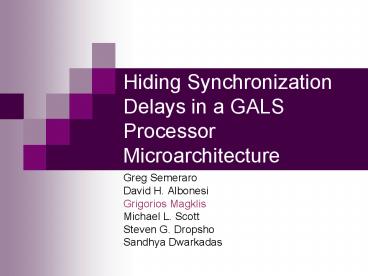Hiding Synchronization Delays in a GALS Processor Microarchitecture PowerPoint PPT Presentation
1 / 13
Title: Hiding Synchronization Delays in a GALS Processor Microarchitecture
1
Hiding Synchronization Delays in a GALS Processor
Microarchitecture
- Greg Semeraro
- David H. Albonesi
- Grigorios Magklis
- Michael L. Scott
- Steven G. Dropsho
- Sandhya Dwarkadas
2
Why GALS?
- Simplified clock distribution network
- Reduced clock power dissipation
- Allows modular design of the processor
- Can run each domain at optimal frequency
- Can use conventional design and testing methods
- Fine-grained DVS/DFS
3
But there is a cost
- Inter-domain synchronization can hurt performance
- Synchronization circuit costs in area and power
- We have to be careful how we divide the processor
4
The MCD Microprocessor
5
Inter-domain Synchronization
- Queue design based on Chelcea and Nowick (WVLSI
00) - Modified for Issue Queue configuration
- Synchronization circuit based on Nyström and
Martin (WCED 02) - Converted to single-rail logic
- Timing analysis based on Sjogren and Myers
(ARVLSI 97) - Skip a cycle rather than pause the clock
6
Synchronization via Queues
- FIFO Queue
- Issue Queue
7
Timing Analysis
- Source runs with CLK1, destination with CLK2
- Source writes at edge 1
- If T gt Ts then the data can be used at edge 2
- If T lt Ts then the data can be used at edge 3
- 25 lt Ts lt 35
8
Simulation Methodology
- Two processor pipelines
- Alpha 21264
- StrongARM SA-1110
- Synchronization penalty was measured against an
identical synchronous design - 30 benchmarks
- MediaBench, Olden, SPEC 2000
9
Simulation Methodology
- Simplescalar Wattch MCD
- Independent clock for each domain
- Independent jitter for each domain
- Next edge based on period, last edge, jitter
- When source and destination clocks are too close,
one cycle penalty is assessed
10
Synchronization Analysis
- OoO and superscalar capabilities removed from
Alpha
11
Synchronization Analysis
- OoO and superscalar capabilities added to
StrongARM
12
What we have learned
- Synchronization penalty doesnt mean performance
loss - Out-of-order execution allows useful work to be
performed when instructions are delayed - Superscalar design means that synchronization
penalties can be shared across multiple
instructions - For Alpha 95 of penalty hidden
- For StrongARM 63 of penalty hidden
- We have to be careful
- Cannot have too many domains
- Careful where you split!
13
Conclusions
- GALS is a good idea for real processors
- small IPC loss
- clock network simplification
- reduction in power dissipation
- higher frequency
- independent domain tuning

